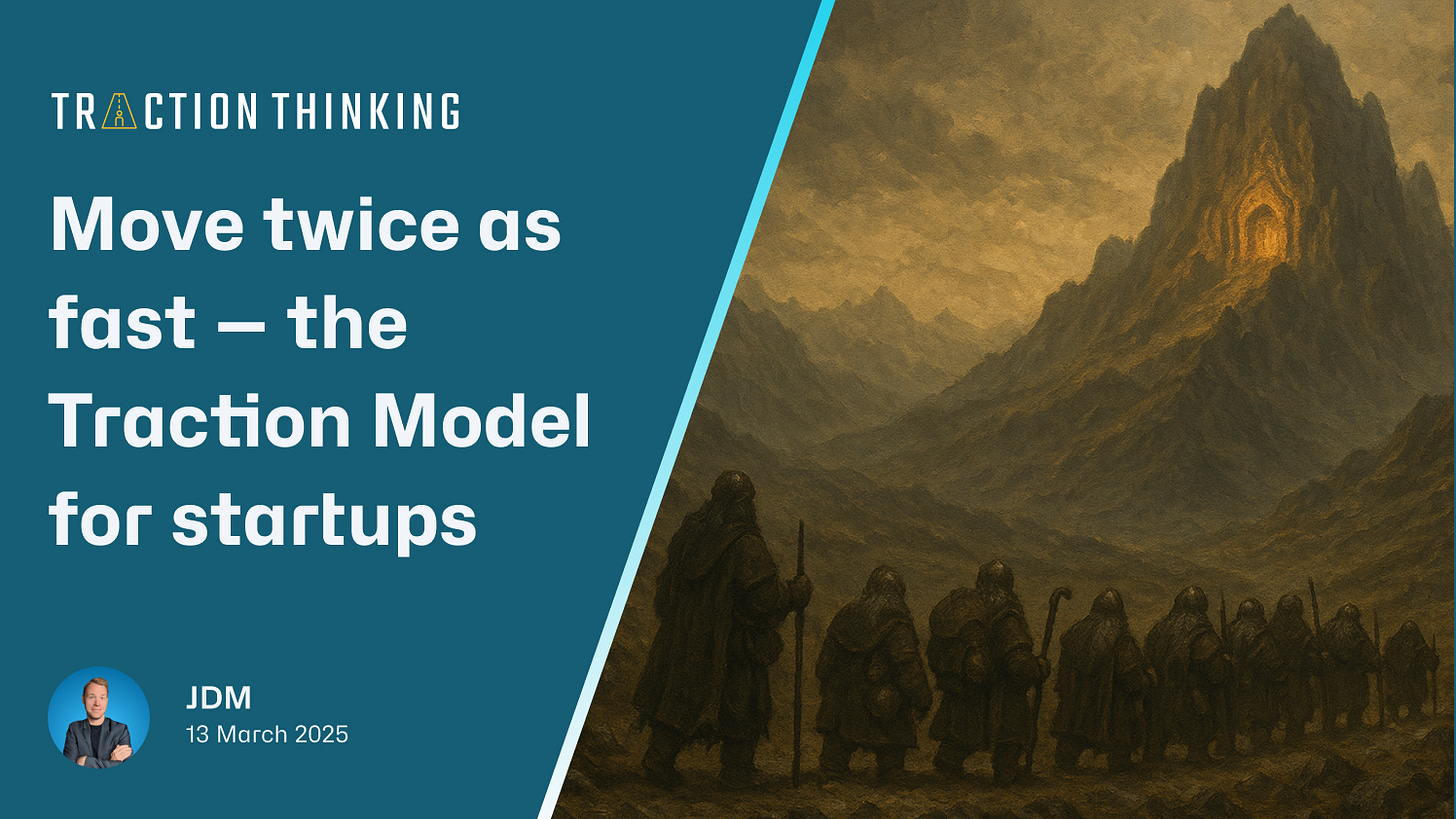🧠 Move twice as fast — the Traction Model for startups
Reach your next milestone in half the time — without burning time or money on the wrong things.
Hey friends 👋
Finding traction in the market is simple.
It’s brutally hard, but refreshingly un-complicated.
So I’m going to share with you today the exact framework we use with our Traction Lab portfolio companies to find rapid progress in the market. We call it the Traction Model — surprisingly simple, but extraordinarily effective.
Let’s dive deep 👇
⏰ REMINDER ⏰
I’m hosting live office hours right here on Substack Fridays at noon. Ask me anything!
Most startups struggle to find traction.
If you’ve been in the startup trenches as long as I have, you’ve seen (and made) the same mistakes I have:
♾️ Throwing everything at the wall — Founders try to do everything at once, without a structured path to prove what actually works.
🐿️ Chasing distractions — A competitor makes a move, an investor asks for something new, a friend suggests TikTok… and poof — your focus is gone.
📏 Measuring the wrong things — Vanity metrics (like press mentions, social followers, pitch competition wins, and many others…) feel like progress but don’t actually prove traction.
What you need isn’t just movement. You need structured momentum — a way to move with clarity, make measurable progress, and avoid wandering into a swamp of second-guessing.
It’s like trying to reach the Lonely Mountain:
You need to know where it is.
You need to measure if you’re actually getting closer.
And you need to show you’re not taking the scenic route through Mirkwood.
This is where the Traction Model comes in.
Think of your startup’s path to traction like a three-legged stool. Pull out one leg, and it collapses.
That’s why the Traction Model has three tightly connected components — each one reinforces the others.
The three components of the Traction Model:
The Traction Model itself – A way to define what you’re chasing, what success looks like, and what kind of business you’ll be if you actually get there.
Milestone-Based Progression — A path of key Decision Points that test your riskiest assumptions on the road to that milestone, keeping you focused and accountable.
Iterative Validation — A process of fast, focused experiments that deliver just enough insight to know if you’re on the right track — or way off.
To turn your startup journey into something more “data-driven odyssey” and less “blindfolded treasure hunt”, let’s break these down.
First, we need to define the destination:
1️⃣ The Traction Model
Being a startup founder is kinda like being a dwarf trying to retake Erebor. There’s a far-off mountain you’re trying to get to, but you can’t just leap there.
It’s not a leisurely nature walk; it’s an expedition. It’s dangerous, and it takes days or weeks or months.
Often, you can’t even see the mountain through the dense forest foliage.
A map alone won’t help. You have to look for signals that you’re on the right track:
Is the river bank still to our right?
Are the stars oriented to our destination?
When we can see it, is the mountain getting larger?
etc.
Similarly, your job as an entrepreneur is to find the signals that you should be seeing if you’re getting closer to the Lonely Mountain — to the goal of a scalable business. But you can’t interpret those signals without a model.
In the dwarves’ journey to Erebor, the model is a cartographic map.
In startups? There’s not map. And worse — it’s not even clear the mountain exists.
You’re more Percy Fawcett than Thorin Oakenshield. You’re hunting the Lost City of Z — a place you believe is out there, but no one’s proven it yet.
So before you draw a map, define what you’re actually chasing. That starts with your startup core. Once the destination is clear, you can define how you think you’ll get there.
That thinking? That’s the Traction Model.
It reframes traction not as a moment, but as a process — one of accumulating evidence that you’re solving a real problem for a real market.
What is the next major milestone?
Without a clear milestone, you’re just wandering.
You need to know where you’re going, why it matters, and how you’ll recognize it when you get there.
For most early-stage startups, a good milestone is 6–18 months away: any sooner, and it’s not significant enough to drive progress; any further out, and it’s closer to wish-casting.
Let’s say yours is, “We’re going to raise a $2M seed round in six months.” Boom — now you have a destination. You can work backward from that.
But here’s the kicker — this milestone needs to be backed by a solid business hypothesis.
You need a theory of what your business looks like when you hit it. Otherwise, you’re just riding a barrel downstream and hoping it leads in the right direction.
For example, when you aim for that $2M seed round, you’ll need more than just a pitch deck — you’ll need to check off the 8 Ts of Fundability:
Team – Are the right people in place to make this happen?
TAM (Total Addressable Market) – Is the market big enough?
Timing – Why is now?
Traction – Is there clear evidence of real demand?
Theory – Can you take it to market and scale it?
Technology – Is is defensible?
Terms – Are you investor-ready?
Tracking – Are you measuring the right things?
Once you map your future state onto the 8 Ts, you compare that to where you are now — and you can start planning how to close the gaps.
And that leads us to the next component:
2️⃣ Milestone-Based Progression
Now that you’ve defined your major milestone, you need to break it down into something usable — Decision Points.
Decision Points are those key moments where you pause, look at the data, and ask:
“Are we still headed in the right direction?”
They’re the startup equivalent of checking your compass in the middle of the forest. They force clarity, prevent drift, and — most importantly — keep you from wandering off into the land of vibes and wishful thinking.
Each Decision Point is a test. You’ve got a hypothesis. You’ve got data. Now you decide:
Do we double down?
Do we adjust course?
Or do we blow it all up and try something else?
Here’s the big idea: your milestone isn’t one big decision — it’s a sequence of smaller ones. And each one needs to be:
Clearly defined
Time-bound
Anchored in evidence
And they are always data-driven decisions.
Let’s say your milestone is raising a $2M seed round. You might break it into Decision Points like:
Validate customer segment – are we targeting the right early adopters?
Validate go-to-market strategy – can we acquire customers efficiently?
Validate product-market fit – are people actually using (and paying for) the product?
Each of these checkpoints does two things:
Keeps you focused – no more wasting time on random distractions.
Forces key decisions – pivot, persevere, or pack it in.
This is where most startups get it wrong: they treat the big milestone like a distant mirage instead of a sequence of high-leverage decisions.
But breaking that big milestone down into Decision Points means you’re:
Defining the decision you need to make
Identifying what data you need to make it
Pre-defining what success (or failure) looks like
And when you’re going to decide
That’s real traction discipline — not just chasing momentum, but measuring it.
But that’s still fairly macro, so we need the third pillar:
3️⃣ Iterative Validation
A beautifully designed slide deck doesn’t prove anything.
Only data proves progress.
That’s where iterative validation comes in. Once your Decision Points are set, you need a system for gathering the data that fuels them.
Not vibes. Not guesses. Not “we’ll see what happens”.
Actual insight from actual experiments.
Each experiment starts with a falsifiable hypothesis — a specific, testable claim. Not a hope. Not a wish. Something that could be wrong.
Here’s what that looks like:
Hypothesis: If we run targeted LinkedIn ads for 30 days to our ideal customer segment, we’ll get a 10% conversion rate and a cost per lead under $50.
Experiment: Run the ads, track the results.
Outcome: Did we hit the targets?
Yes = double down.
No = pivot, persevere, or pack it in.
The key here is rapid experimentation. If something doesn’t work, pivot and move forward quickly. Because every test gives you signal. Every cycle gets you smarter.
That’s what iterative validation does:
It builds feedback loops into your startup — real data, in real time, to guide your next move. It helps you avoid wasting time, talent, and treasure on strategies that simply aren’t working.
No more wandering. No more sunk-cost delusions.
Just a steady, focused march toward evidence-based traction.
The goal is to put in as few resources as possible to find out if you’re on the right track — because the wise founder proportions their effort to the evidence.
And when things don’t go the way you hoped?
Because most experiments will fail.
In the world of startups, getting it wrong isn’t the worst thing that can happen — it’s ignoring the data that will kill you.
In other words, being wrong early is infinitely better than being wrong expensively.
The beauty of this process is it doesn’t just help you make progress — it tells you when to stop.
In other words:
When your experiments fail, you’ve got three moves:
🤷♂️ Minor Pivot – Small tweaks (e.g., change the targeting, tweak the copy, shift positioning).
😬 Major Pivot – Big structural changes (e.g., new customer segment, new channel, new model).
😅 Existential Pivot – Full stop. Reassess the entire strategy. Maybe the business.
None of these are failure. They’re forward motion — if you learn fast and move faster.
The only real failure?
Ignoring the data because you’re too stubborn to stop.
These three components accelerate your traction.
Most founders get stuck in two predictable traps:
Going all-in on a huge goal without validating whether it’s achievable.
Delaying decisions because they’re waiting for certainty that never comes.
The Traction Model avoids both with it’s three-pronged approach:
The Traction Model defines what you’re chasing — and how you’ll know when you’re getting closer.
Milestone-based progression breaks that journey into focused, high-leverage Decision Points.
Iterative validation keeps you grounded in data, not guesswork.
Together, they let you move twice as fast — because you’re making smaller bets, smarter decisions, and better use of your time, money, and energy.
You’re not just building a company.
You’re building a system for proving one.
Want to define your Traction Model and start making rapid forward progress?
Until next week,
—jdm
PS: If you enjoyed this post, please take a moment to share it with a friend. These take me hours to write, but only 3 minutes for you to help me out. Thanks!



